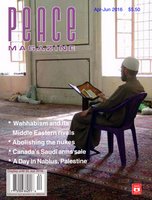
Peace Magazine Apr-Jun 2016, page 29. Some rights reserved.
Search for other articles by Subir Guin here
The Wahhabi Cult and the Hidden Roots of Modern Jihad. By Charles Allen. London: Little Brown and Company, 2006
Charles Allen, a British historian, who has spent much of his adult life in the sub-continent, chronicles the progress—if one can call it that!—of Wahhabism and its fundamentalist variations from its roots in Arabia. The ideology, incubated among nomadic Bedouin tribes, was not espoused everywhere in the beginning. But it was championed by the patriarch of the current Saudi dynasty, who implemented a version of Sharia law that was strictly enforced, and remains so to this day.
Muslim scholars of the Quran took their message to their co-religionists in British India in the early 1800s, setting up madrassas (seminaries) in Peshawar, Delhi, Patna, Calcutta and other centres where Muslims constituted a significant minority of the local population. Their interpretation of the Quran was so narrow that it fostered absolute intolerance for all other faiths “ including sects within the Muslim community, where religious practices were different or not rigorously enforced.
At first the government of (British) India took a laissez-faire attitude toward this movement until they realized that Muslims were being enjoined by the zealots to attack their infidel rulers. When Col. Frederick Mackeson, a senior commissioner in Peshawar was assassinated in 1853 by a “Hindustani Fanatic” “ one of several groups operating in what was regarded as an ungovernable region of the North West Frontier, the government began to monitor the activists, and discovered a network of armed and well-organised men who were prepared to wage war against the administration.
This attempt to rally Muslims against their colonialist rulers coincided with a rising tide of nationalism among Indians in general. What the Brits termed “the Sepoy Mutiny” is now referred to as India’s first war of independence. The Indian National Congress, as most students of history know, brought together people from a wide range of communities—regardless of religion, caste or ethnicity—whose members were deeply involved in the struggle for independence.
Aside from one solitary mention of this body, the author seems to have totally ignored the views of major segments of India’s population: Hindus and other minorities, including Muslims who distanced themselves from the fundamentalists. Surely they must have expressed some concerns about the spread of Wahhabist ideas in a multi-religious, multi-cultural society, striving to build a nation that would offer its citizens something very different: freedom of speech and religion.
When the country was partitioned in 1947, there were approximately 200 madrassas scattered across Pakistan.
By 1972 that number jumped to 899: undoubtedly the proliferation of similar centres of indoctrination in India, though less dramatic, remains a concern for the current administration. This problem is of course shared today by other countries on every continent.
Readers may be astonished to see how little has changed in the convictions of today’s leaders of ISIS from those of Muhammad ibn al-Wahab back in the 1800s. What is more unfathomable is their absolute refusal to entertain any reinterpretations of the Quran, despite vast changes in our way of living over the past two centuries. Yet they have embraced the latest forms of social media to spread their gospel and recruit adherents from all corners of the planet.
Reviewed by Subir Guin, an editor of Peace.

Peace Magazine Apr-Jun 2016, page 29. Some rights reserved.
Search for other articles by Subir Guin here